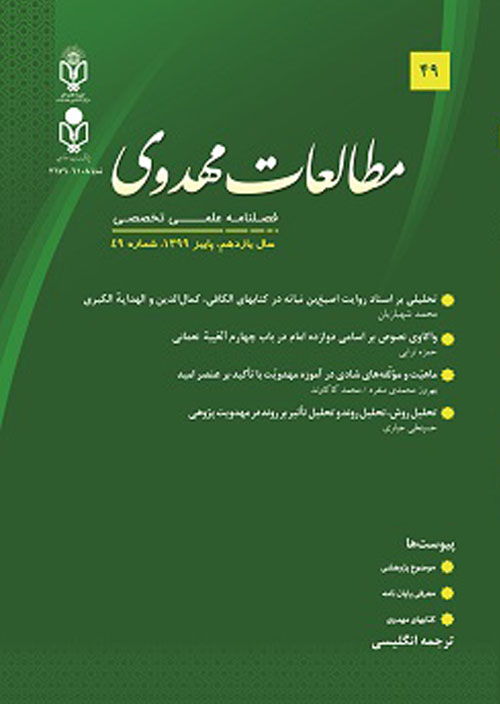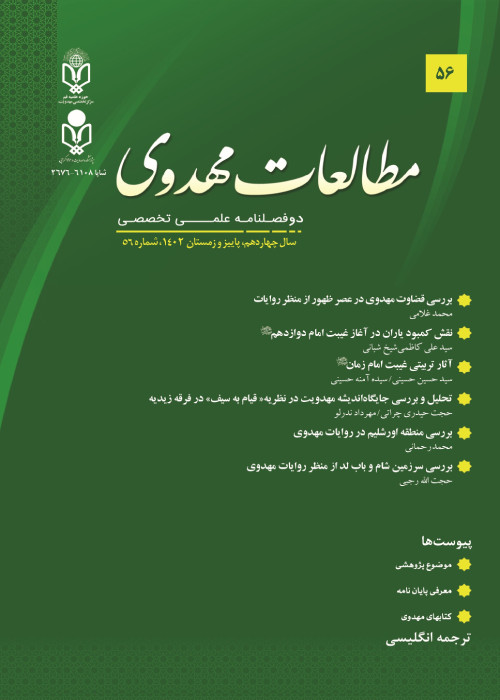فهرست مطالب

نشریه مطالعات مهدوی
پیاپی 49 (پاییز 1399)
- بهای روی جلد: 500,000ريال
- تاریخ انتشار: 1399/11/15
- تعداد عناوین: 8
-
صفحه 7
محدثان امامیه در تحلیل خود بر تعارض احادیث، قواعدی را مشخص کرده اند که توسط آنها یا جمع میان ادله صورت گرفته یا یکی را بر دیگری ترجیح می دهند. از قراین ترجیح می توان به اعتبار سند و دقت راویان و همچنین تعدد اسناد اشاره کرد. یکی از این گزارش ها که در دوره های مختلف تاریخ حدیثی و کلامی امامیه مورد استفاده قرار گرفته، گزارشی منقول از دیدار اصبغبننباته با حضرت علی7 و بیان وجود امام مهدی4 و رخداد غیبت برای ایشان است. شهرت این روایت بهدلیل وجود دو فراز: «من ظهر الحادی عشر من ولدی» و «کم تکون الحیره، سته ایام او سته اشهر او ست سنین» است. این دو قسمت از روایت منجر به برداشتهای مخالف با آموزه های قطعی نزد امامیه مانند دوازدهنفربودن ایمه% و مدت زمان مشخص برای غیبت صغرا و نامشخص برای غیبت کبرا شده است. شارحان حدیث در دو سده اخیر تلاش کردهاند تا به تبیین آن پرداخته و راهحل رفع تعارض ظاهری میان این دو فراز با آموزه های قطعی امامیه را ارایه دهند. نویسندگان معاصر نیز در مقام پاسخ گویی به دیدگاه جریانهای انحرافی مانند احمد اسماعیل بصری همت گماشتهاند. با توجه به تفاوت سند روایت در کتاب الهدایه الکبری (این سند از ابتدا تا اتصال به اصبغبننباته با دیگر اسناد تفاوت دارد)، تعدد اسناد شیخ صدوق به این گزارش و تمایز متن او با متن کلینی، به بررسی سه سند مندرج در منبع متقدم (کافی)، منبع پر إسناد (کمال الدین) و منبع متفاوت (الهدایه الکبری) میپردازیم.
نگارنده گمان دارد که با توجه به قواعد فهم روایت، توجه به نسخهبدل، خانواده حدیث و فهم عالمان متقدم از روایت، گزارش پیش گفته قابلتوجیه بوده و مخالفتی با عقاید امامیه ندارد. از طرف دیگر با توجه به قراین مختلف، از جمله اسناد متعدد و اعتنای محدثان ضابط به متن مندرج در کتاب کمال الدین و پیراستگی متن از هرگونه ابهام، نقل شیخ صدوق بر دیگر نقل های صورت گفته ترجیح داشته و مورد قبول است. این پژوهش با روش تحقیق آمیزه ای تلفیقی و دادهپردازی توصیفی – تحلیلی به موضوع پرداخته است.کلیدواژگان: تحلیل فهرستی، اسناد، اصبغ بن نباته، کافی، الهدایه الکبری، کمال الدین -
صفحه 45
کتاب «الغیبه نعمانی» از نگاشتههای اختصاصی پیرامون آموزه مهدویت است. یکی از بخشهای پراهمیت این کتاب، باب چهارم آن با نام «باب ما روی فی ان الایمه اثنا عشر إماما و انهم من الله و باختیاره» است. اهمیت این باب در گردآوری نصوصی است که نام امامان معصوم% در آنها وارد شده است. پژوهش پیشرو با روش تحلیلی- توصیفی در پی آن است که با گونهشناسی و بررسی روایات این باب، میزان اعتبار و دلالت آنها را واکاوی کند. یافتههای این نگاشته بر آن است که نسبت به افراد مختلف در جامعه مخاطبان، نصوص از درجه دلالت متفاوتی برخوردار بوده است. برخی بر کلیت عدد دوازدهگانه و شماری نیز بر نامبردن تکتک آن بزرگواران، رهنمون بوده است. بنابراین نگاه جامع به همه آن روایتها پاسخگوی شناسایی امامان خواهد بود.
کلیدواژگان: الغیبه، نعمانی، دوازده امام، امامان%، اثناعشر، باب چهارم -
صفحه 85
شادی و نشاط از مهم ترین نیازهای فطری هر انسانی بوده و دین مبین اسلام نیز در راستای ایجاد آن برنامه دارد. آنچه در این پژوهش اهمیت داشته و هدف اصلی آن بهشمار می آید، بررسی ماهیت و مولفه های شادی و نشاط در اندیشه مهدویت است. با توجه به توصیه های روایات، به حزن و اندوه در فراق امام مهدی4 در قالب هایی چون دعای ندبه، چنین به ذهن متبادر می شود که زندگی منتظر امام مهدی4 همواره اندوهگین است؛ بنابراین مسئله ای که باید مورد توجه قرار بگیرد این است که «آیا مولفه های مهدویت سازگار با اصل شادی و نشاط هستند؟» فرضیه ما این است که در اندیشه مهدویت، جنسی از شادی و نشاط وجود دارد که با شادی و نشاط امروزی متفاوت است. ما در این نوشتار از روش جمع آوری داده ها، توصیف و تحلیل آنها، جهت دستیابی به جواب مسئله استفاده کرده ایم. یافتههای پژوهش حاکی از این است که در باورداشت مهدویت شاهد تکمیل و تعالی شادی و نشاط هستیم. در آموزههای مهدویت بهدلیل وجود شاخصه هایی مانند، امید به آینده، معنابخشی به زندگی، حزن و اندوه هدفمند و... شاهد نشاط و شادی هستیم.
کلیدواژگان: شادی، نشاط، سبک زندگی، انتظار، مهدویت -
صفحه 115
آیندهپژوهی و آیندهنگاری هنر شکلدادن و ترسیم آینده است که به شناخت و مطالعه آینده های گوناگون از جمله ممکن، محتمل، مرجح، مطلوب و قطعی میپردازد. مهدویتپژوهی بر اساس آموزه های دینی، ساحت و روشی برای حرکت به آینده ای پویا و مطلوب با تمسک به گزاره های دینی است که وظیفه حرکت بهسمت آینده مطلوب و قطعی را بر عهده دارد. مسئله مطرح در این نوشتار چگونگی و تعیین سطح تحلیل و کاربست روش تحلیل روند و تحلیل تاثیر بر روند در ساحت های مهدویتپژوهی است. از این رو این نوشتار با روش توصیفی و تحلیلی به تبیین روش تحلیل روند و تحلیل تاثیر بر روند در مهدویت می پردازد. قابلیت عملیاتی این روش در ساحت های مهدویتپژوهی و مواجهشدن با آینده مطلوب و مرجح، مهمترین دستاورد تحقیق پیش رو خواهد بود.
کلیدواژگان: مهدویت پژوهی، آینده پژوهی، تحلیل روند، تحلیل تاثیر بر روند -
صفحه 127
-
صفحه 128
-
صفحه 129
-
صفحه 139
-
Page 7
In their analysis on the conflict of hadiths, the Imami narrators have specified rules by which they either combine the evidence or prefer one over the other. Preferences include the credibility of the document and the accuracy of the narrators, as well as the multiplicity of documents. One of these reports, which has been used in different periods of the hadith and theological history of the Shia, is a narrated account of Asbagh Ibn Nabata's meeting with Imam Ali (A.S) and the statement of the existence of Imam Mahdi (A.S) and the occurrence of his absence. The fame of this narration is due to the existence of two ups and downs: "the one who appears to be the eleventh of my children"2 and "how long is the confusion, six days, or six months or six years"3. These two parts of the narration have led to perceptions contrary to the definite teachings of the Imams, such as the number of Imams to be twelve individuals and the specific time for the minor Occultation and the indefinite duration for the major Occultation. The commentators of hadith in the last two centuries have tried to explain it and offer a solution to the apparent conflict between these two parts with the definite teachings of the Imams. Contemporary writers have also tried to respond to the views of deviant movements such as Ahmad Ismail Basri. Considering the difference between the document of the narration in the book of Al-Hidaya Al-Kubra (this document is different from other documents from the beginning to its connection to Asbagh Ibn Nabata), the multiplicity of documents of Sheikh Saduq to this report and the distinction of his text with the text of Koleini, we will examine the three documents contained in the earlier source (Kafi), the well-documented source (Kamal al-Din) and a different source (Al-Hidaya al-Kubra). The author thinks that according to the rules of understanding the narration, paying attention to the copied transcript, the family of the hadith and the understanding of the narration by the earlier scholars, the above report is justifiable and does not contradict the Imami beliefs. On the other hand, according to various evidences, including numerous documents and the attention of the narrators to the text in Kamal al-Din's book and the text being free from any ambiguity, Sheikh Saduq's quotation is preferable and acceptable to other quotations. This research has dealt with the subject with the method of integrated research and descriptive-analytical data processing.
Keywords: list analysis, documents, Asbagh Ibn Nabata, Kafi, Al-Hidayah Al-Kubra, Kamaluddin -
Page 45
The book "Al-Ghaybah Nu'mani" is one of the exclusive writings on the doctrine of Mahdism. One of the most important parts of this book is its fourth chapter, entitled " Chapter on what was narrated about the twelve Imams and that they are from God and by His choice."2 The importance of this chapter is in compiling the texts in which the names of the infallible Imams are included. The present research with analytical-descriptive method seeks to investigate the validity and meaning of narrations in this chapter by typology and study of the narrations in this chapter. The findings of this paper suggest that the texts had different degrees of reasoning for different people in the audience. Some have led to the totality of the number twelve and some to the naming of each of those nobles. Therefore, a comprehensive look at all those narrations will be the answer to the identification of Imams.
Keywords: Al-Ghaybah, Nu'mani, Twelve Imams, Imamate, twelve, chapter four -
Page 85
Happiness is one of the most important natural needs of every human being and the religion of Islam has a plan to create it. What is important in this research and is its main purpose is to study the nature and components of happiness and vitality in the idea of Mahdism. According to the recommendations of the narrations, because of the grief and sorrow at the separation of Imam Mahdi (A.S) in forms such as Nadbah prayer, it comes to mind that life of a person waiting for Imam Mahdi (A.S) is always sad; Therefore, the question that must be considered is "Are the components of Mahdism compatible with the principle of happiness and vivacity?" Our hypothesis is that in the idea of Mahdism, there is a type of joy and happiness that is different from today's happiness and joy. In this paper, we have used the method of data collection, description and analysis to achieve the answer to the problem. The findings of the research indicate that in the perception of Mahdism, we see the completion and transcendence of joy and happiness. In the teachings of Mahdism, due to the existence of characteristics such as hope for the future, meaning in life, sorrow and purposeful sorrow, etc., we witness joy and happiness.
Keywords: happiness, cheerfulness, lifestyle, awaiting, Mahdism -
Page 115
Futures studies and futurism is the art of shaping and mapping the future, which recognizes and studies various futures, including possible, probable, preferred, desirable and definite futures. Mahdism-research based on religious teachings is a field and a way to move towards a dynamic and desirable future by relying on religious propositions that are responsible for moving towards a desirable and definite future. The issue raised in this paper is how to determine the level of analysis and application of the method of process analysis and impact analysis on the process in the fields of Mahdism research. Therefore, this article uses a descriptive and analytical method to explain the method of process analysis and impact analysis on the process in Mahdism. The operational capability of this method in the fields of Mahdism research and facing a desirable and preferred future will be the most important achievements of the forthcoming research.
Keywords: Mahdism, research, future research, process analysis, impact analysis


